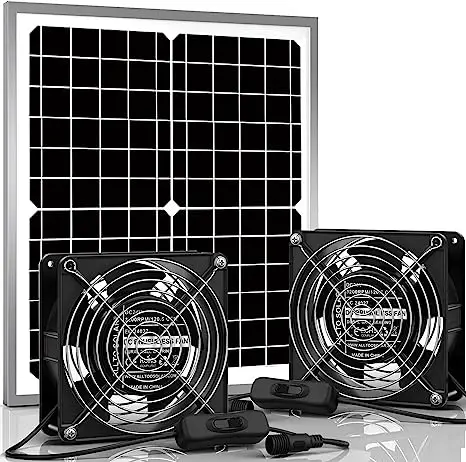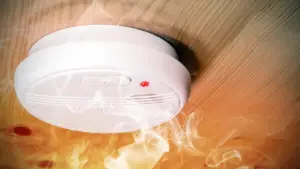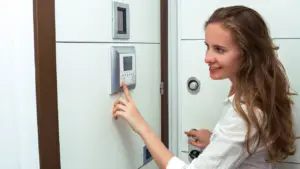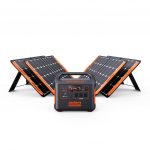Solar fans are innovative devices that utilize solar energy to provide cooling and ventilation in various settings. They harness the power of sunlight through photovoltaic (PV) panels, converting it into electricity to operate the fan. Solar-powered fans offer a sustainable and energy-efficient alternative to traditional fans relying on grid electricity.
Solar-powered fans are designed to relieve heat and improve air circulation in indoor and outdoor spaces. They find applications in residential buildings, commercial establishments, agricultural settings, and even for emergency and disaster relief efforts. These fans offer several benefits by utilizing solar energy, including reduced energy consumption, cost savings, and environmental sustainability.
In this article, we will explore the working principle of solar-powered fans, their advantages, different types available in the market, considerations for choosing the right fan, and various applications where they can be effectively utilized.
We will also discuss case studies and success stories, future trends, and innovations in solar-powered fan technology. Whether you want to enhance your home’s energy efficiency, improve ventilation in your workspace, or explore sustainable cooling solutions, this comprehensive guide will provide valuable insights into the world of solar-powered fans.
Table of Contents
Best Solar Fans
ZenxyHoC Solar Powered Fan
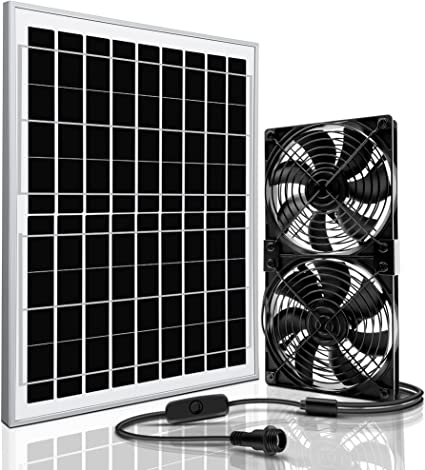
SUN ENERGISE Solar Powered Exhaust Fan Pro
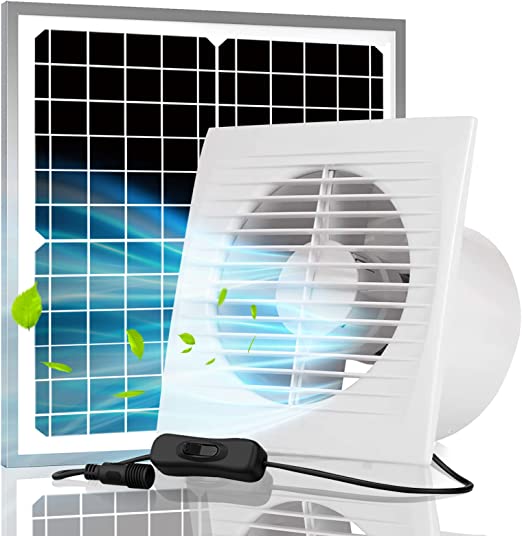
Allto Solar Waterproof Solar Powered Fan
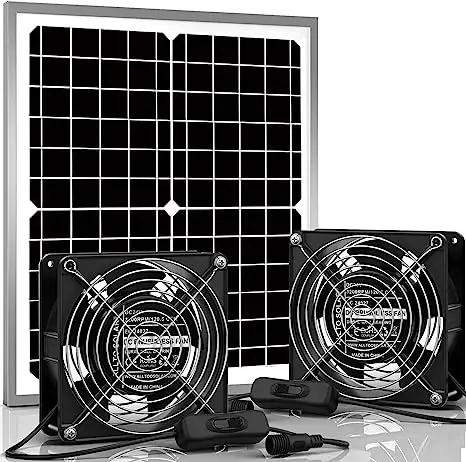
Solar energy
Solar energy refers to the radiant energy emitted by the Sun, which can be harnessed and converted into usable forms of power. It is a renewable and sustainable energy source vital in transitioning towards cleaner and more environmentally friendly energy systems. Solar energy is abundant, widely available, and has the potential to meet a significant portion of the world’s energy needs. By harnessing solar energy, we can reduce our reliance on fossil fuels, mitigate climate change, and achieve a more sustainable future.
Working principle of solar-powered fans
Photovoltaic (PV) technology
Photovoltaic (PV) technology is a method of converting solar energy directly into electricity using semiconductor materials. PV technology harnesses the photovoltaic effect, which occurs when certain materials, such as silicon, are exposed to sunlight. This process allows the materials to absorb photons (light particles) and release electrons, generating an electric current.
The key components of a photovoltaic system include:
Solar Panels (Photovoltaic Modules): Solar panels consist of multiple PV cells interconnected to form a module. These panels are typically silicon-based semiconductors, which absorb sunlight and convert it into electricity. The efficiency of solar panels in converting sunlight into electricity has improved over time, allowing for more effective utilization of solar energy.
Inverter: The direct current (DC) electricity generated by solar panels needs to be converted into alternating current (AC) to be compatible with most electrical appliances and the power grid. An inverter is used to perform this conversion, ensuring that the electricity generated by the PV system is suitable for use in homes and businesses or fed back into the grid.
Mounting and Tracking Systems: Solar panels are typically mounted on rooftops or ground-mounted structures, depending on the application. Mounting systems provide stability and optimal positioning to capture sunlight. In some cases, solar tracking systems may be used to adjust the angle and orientation of the panels throughout the day to maximize their exposure to sunlight.
Balance of System Components: PV systems include various system components, including wiring, connectors, junction boxes, and safety equipment. These components ensure proper electrical connections, protection against overcurrent or overvoltage, and system reliability.
Conversion of solar energy into electricity
Conversion of solar energy into electricity involves the transformation of sunlight into usable electrical power. This process primarily occurs through photovoltaic (PV) cells, the key components of solar panels. Here is an overview of the conversion process:
Photovoltaic Effect: PV cells are made of semiconductor materials, typically silicon, with unique properties that allow them to convert light energy into electricity. When sunlight (composed of photons) strikes the PV cell, it excites the electrons in the semiconductor material, causing them to be released from their atoms.
Electron Flow: The freed electrons flow through the semiconductor material due to an internal electric field created within the PV cell. This flow of electrons creates direct current (DC) electricity.
Electrical Circuit: The DC electricity generated by individual PV cells is then combined in a series and parallel configuration to form a solar panel. Multiple panels can be connected to create a solar array or system. The electrical circuitry connects the panels, allowing the flow of electrons through the circuit.
Inverter Conversion: The DC electricity produced by the solar panels needs to be converted into alternating current (AC) electricity, which is the standard form used by most appliances and the power grid. An inverter is used to perform this conversion, changing the current type and adjusting voltage levels to match the requirements of the electrical system.
Power Distribution: The inverter’s AC electricity can now power electrical devices, lighting, and appliances or feed back into the electrical grid. For grid-connected systems, excess electricity produced during times of high solar generation can be exported to the grid, and electricity can be drawn from the grid when solar generation is insufficient.
The efficiency of the conversion process depends on various factors, including the quality of the PV cells, sunlight intensity, temperature, and shading. Advances in PV technology have led to increased efficiency and improved performance of solar panels, making solar energy an increasingly viable and cost-effective option for electricity generation.
Components of a solar-powered fan
Solar-powered fans are designed to be efficient, environmentally friendly, and independent of traditional electrical power sources. By utilizing the energy from the Sun, they offer a sustainable and cost-effective solution for cooling and ventilation in various settings, including homes, offices, greenhouses, and outdoor spaces.
Solar Panel: The solar panel is the core component of a solar-powered fan. It consists of photovoltaic (PV) cells that convert sunlight into electricity. The solar panel captures solar energy and generates the power required to operate the fan.
DC Motor: A solar-powered fan utilizes a direct current (DC) motor to convert electrical energy into mechanical energy. The DC motor is designed to be highly efficient and operates on the electricity produced by the solar panel.
Fan Blades: The fan blades are responsible for creating airflow and circulation. They are typically made of lightweight materials such as plastic or metal. They are designed to move air efficiently when powered by the DC motor.
Frame and Housing: The frame and housing provide structural support and protection for the fan’s internal components. They are typically made of durable materials like plastic or metal, ensuring the fan’s stability and longevity.
Battery (Optional): Some solar-powered fans may include a rechargeable battery. The battery stores excess solar energy generated during the day, allowing the fan to continue operating during periods of low sunlight or at night. The battery provides backup power, ensuring continuous fan operation even when solar energy is unavailable.
Controls and Switches: Solar-powered fans often feature control mechanisms and switches to adjust fan speed, activate oscillation (if applicable), and turn the fan on or off. These controls provide convenience and flexibility in operating the fan according to user preferences.
Ventilation Ducts (for specific fan types): Additional components like ventilation ducts may be included in certain applications, such as solar attic fans or solar ventilation fans. These ducts facilitate air movement from the fan to the desired area, helping ventilate and cool the space effectively.
Advantages of solar-powered fans
Environmental benefits of solar-powered fans:
Energy Efficiency: Solar powered fans utilize solar energy, a renewable and clean energy source. By harnessing the power of the Sun, solar fans operate without consuming electricity from the grid. This results in reduced energy consumption and a lower carbon footprint than traditional fans that rely on electricity generated from fossil fuels.
Reduced Greenhouse Gas Emissions: Solarspowered fans do not produce greenhouse gas emissions during operation since they rely solely on solar energy. By using solar fans instead of traditional fans powered by electricity generated from fossil fuels, we can contribute to mitigating climate change and reducing air pollution.
Lowered Electricity Demand: Solar fans reduce the grid’s electricity demand, particularly during peak hours. By using solar energy directly, these fans help alleviate the strain on power plants, which often rely on non-renewable energy sources and can contribute to environmental degradation.
Off-Grid Capability: Solar-powered fans are suitable for off-grid or remote areas where access to electricity may be limited. By utilizing solar energy, these fans offer a sustainable cooling and ventilation solution without the need for grid connectivity or additional infrastructure development.
Noise and Pollution Reduction: Solar fans operate silently and do not emit noise or pollution during use; This is especially beneficial for indoor applications or noise-sensitive environments where traditional fans may generate noise or require electricity from noisy generators.
Sustainable Cooling Solution: Solar-powered fans provide a sustainable alternative for cooling and ventilation needs. By utilizing renewable energy, they offer a greener option than traditional cooling systems, such as air conditioners, which consume significant amounts of electricity and contribute to greenhouse gas emissions.
Longevity and Durability: Solar fans are designed for durability and long lifespan. Their efficient operation and minimal maintenance requirements contribute to reduced waste and a smaller environmental impact compared to fans that may require frequent replacement or repairs.
By harnessing solar energy, solar-powered fans offer environmental benefits such as energy efficiency, reduced greenhouse gas emissions, and lower electricity demand. They provide a sustainable, eco-friendly cooling and ventilation solution, promoting a greener and healthier environment.
Cost Savings of Solar-Powered Fans:
Reduced Electricity Bills: Solar-powered fans operate using energy from the Sun, which means they do not rely on electricity from the grid. Using solar energy instead of conventional electricity, solar fans can significantly reduce or eliminate the cost of running traditional electric fans, resulting in lower electricity bills.
Long-Term Savings: Investing in solar-powered fans can lead to long-term cost savings. While the initial upfront cost of purchasing and installing a solar fan may be higher than a traditional one, the ongoing operational costs are significantly lower since solar energy is free and abundant. Over time, the savings on electricity bills can outweigh the initial investment, resulting in cost savings in the long run.
Independence from Energy Price Fluctuations: Solar-powered fans provide independence from fluctuating electricity prices. As the cost of electricity from the grid can vary over time, using solar energy allows you to mitigate the impact of these price fluctuations and maintain a more stable and predictable cooling and ventilation cost.
Maintenance and Repair Savings: Solar fans typically require minimal maintenance and have fewer moving parts than traditional fans; This can result in lower maintenance and repair costs over the fan’s lifetime. Regular cleaning of the solar panels to maintain optimal efficiency is typically the primary maintenance requirement.
Eligibility for Incentives and Rebates: Depending on your location, installing solar-powered fans may make you eligible for various incentives and rebates. These incentives can offset the initial costs of purchasing and installing solar fans, increasing cost savings.
Increased Property Value: Installing solar-powered fans can enhance the value of your property. Solar energy systems are seen as desirable and environmentally friendly features, making your property more attractive to potential buyers if you decide to sell in the future. This increased property value can contribute to overall financial savings.
Versatility and Portability of Solar-Powered Fans:
Versatile Installation Options: Solar-powered fans offer versatile installation options, allowing them to be used in various settings. They can be installed in homes, offices, garages, greenhouses, RVs, boats, camping sites, and other outdoor spaces. Their flexibility in installation makes them suitable for both permanent and temporary cooling and ventilation needs.
Portability: Many solar-powered fans are designed to be portable, making them convenient for use in different locations. Portable solar fans are lightweight and compact, allowing for easy transport and setup wherever cooling or ventilation is required. This portability is useful for outdoor activities, camping, or situations where a fixed installation is not feasible.
Off-Grid Capability: Solar-powered fans are ideal for off-grid applications or areas with limited access to electricity. Their reliance on solar energy allows for independent operation without grid connectivity. This off-grid capability makes solar fans well-suited for remote locations, emergencies, or areas where power outages are common.
Adjustable Angles and Positions: Solar fans often come with adjustable angles and positions, allowing users to direct the airflow as needed. This adjustability ensures optimal ventilation and cooling, enhancing comfort in various environments.
Integrated Battery Backup (in some models): Solar-powered fans come with integrated rechargeable batteries. These batteries store excess solar energy during the day, allowing the fan to continue operating during periods of low sunlight or at night. The integrated battery backup enhances the versatility of the fan by providing continuous operation regardless of solar availability.
Multi-Purpose Functionality: Solar fans often have multi-purpose functionality, offering not only cooling but also features such as LED lights, USB charging ports, or even built-in radios. These additional features increase their versatility and make them useful in various situations, such as camping trips, outdoor gatherings, or emergencies.
Types of Solar-Powered Fans
Solar Attic Fans:
Solar attic fans are designed for ventilating and cooling attics using solar power. They offer several benefits for homeowners and contribute to energy efficiency and improved comfort. Here are some key aspects of solar attic fans:
Function and Operation: Solar attic fans are installed on the roof or gable of a house and are powered by solar panels. They work by drawing in cooler air from outside and exhausting hot air from the attic. As sunlight hits the solar panels, it generates electricity that powers the fan motor, promoting air circulation and removing excess heat and moisture from the attic space.
Improved Attic Ventilation: Effective attic ventilation is crucial for maintaining a healthy and energy-efficient home. Solar attic fans enhance ventilation by actively removing hot air that can accumulate in the attic during hot weather; This prevents the attic from becoming excessively hot, leading to energy waste, increased cooling loads on the air conditioning system, and potential damage to roofing materials.
Energy Efficiency: Solar attic fans operate solely on solar power, eliminating the need for grid electricity. By using renewable energy from the Sun, they reduce energy consumption and lower electricity costs associated with attic ventilation. This energy efficiency makes solar attic fans a sustainable and cost-effective solution.
Moisture Control: In addition to heat removal, solar attic fans also help control moisture levels in the attic. Excess moisture can lead to mold growth, wood rot, and damage to insulation. Solar attic fans assist in removing humid air, preventing condensation and moisture-related issues that can compromise the structural integrity of the attic space.
Easy Installation and Maintenance: Solar attic fans are relatively easy to install, as they do not require electrical wiring or connection to the grid. They typically come with mounting brackets and flashing kits for proper installation on the roof or gable. Once installed, solar attic fans require minimal maintenance, usually limited to periodic cleaning of the solar panels to ensure optimal performance.
Environmental Impact: Solar attic fans contribute to a reduced carbon footprint and a greener environment. Using solar energy instead of grid electricity helps decrease greenhouse gas emissions and reliance on non-renewable energy sources, promoting sustainability and environmental responsibility.
Potential Cost Savings: Solar attic fans can save potential costs by reducing the load on air conditioning systems. By ventilating the attic and lowering its temperature, solar attic fans can help reduce the cooling requirements of the living spaces below, leading to energy savings and lower cooling bills.
Solar Ceiling Fans:
Solar ceiling fans are innovative and energy-efficient fans that operate on solar power. They are designed to provide cooling and air circulation while minimizing energy consumption. Here are some key aspects of solar ceiling fans:
Solar-Powered Operation: Solar ceiling fans have solar panels that convert sunlight into electricity. The solar panels are usually integrated into the fan’s design and are positioned to capture maximum sunlight exposure. The generated electricity powers the fan motor, allowing it to operate without relying on grid electricity.
Energy Efficiency: Solar ceiling fans offer significant energy savings compared to traditional ceiling fans that run on electricity from the grid. Using solar power reduces electricity consumption, resulting in lower energy bills and a reduced environmental impact. Solar ceiling fans are particularly effective in sunny regions with ample sunlight.
Off-Grid Capability: Solar ceiling fans are well-suited for off-grid applications or areas with unreliable or limited access to electricity. They provide a cooling solution without grid connectivity, making them ideal for remote locations, outdoor spaces, or during power outages.
Cooling and Air Circulation: Solar ceiling fans function similarly to traditional ceiling fans by creating a cooling breeze and promoting air circulation. They help improve comfort by reducing the perceived temperature through increased air movement, making the space feel cooler even without air conditioning.
Battery Backup (Optional): Some solar ceiling fans have an integrated rechargeable battery as an additional feature. The battery allows the fan to continue operating during periods of low sunlight or at night, ensuring uninterrupted cooling. The battery can be charged when sunlight is available during the day, providing backup power for extended use.
Easy Installation: Solar ceiling fans are typically designed for easy installation and can be installed similarly to traditional ones. They require proper mounting on the ceiling and connection to the solar panel. Installation may vary depending on the specific fan model and manufacturer’s instructions.
Environmental Benefits: Solar ceiling fans contribute to a greener environment by utilizing clean and renewable solar energy. They reduce reliance on fossil fuels and help lower carbon emissions associated with electricity generation. By choosing solar ceiling fans, homeowners can positively impact the environment and promote sustainability.
Solar Table Fans:
Solar table fans are compact and portable fans powered by solar energy. They offer a convenient and eco-friendly solution for personal cooling and ventilation. Here are some key aspects of solar table fans:
Portable Design: Solar table fans are designed to be lightweight and compact, making them highly portable. They are typically small enough to fit on a table, desk, or flat surface. This portability allows for easy transportation and placement in different locations, both indoors and outdoors.
Solar-Powered Operation: Solar table fans are equipped with solar panels that capture sunlight and convert it into electricity. The solar panels are integrated into the fan’s design and power the fan motor, eliminating the need for external power sources such as batteries or electricity from the grid.
Energy Efficiency: Using solar-powered table fans reduces electricity consumption and increases energy efficiency. They operate without adding to the electricity load of the home or workplace, resulting in lower energy costs and a reduced carbon footprint.
Versatile Usage: Solar table fans are versatile and can be used in various settings. They are suitable for personal use at home, in offices, dorm rooms, camping trips, outdoor events, or any space where direct sunlight is available. Their portable design allows for flexible cooling and ventilation wherever it is needed.
Adjustable Fan Speed and Angles: Many solar table fans come with adjustable fan speed settings and tiltable heads, allowing users to customize the airflow according to their preferences. This feature ensures optimal cooling and comfort in different environments.
Easy Maintenance: Solar table fans typically require minimal maintenance. Regularly cleaning the solar panels to remove dust or dirt ensures efficient solar energy conversion. The fan blades can be easily cleaned to maintain smooth and efficient airflow.
Environmentally Friendly: Solar table fans operate solely on clean, renewable solar energy. They contribute to a greener environment by reducing reliance on non-renewable energy sources and minimizing carbon emissions associated with electricity generation.
Off-Grid Capability: Solar table fans offer off-grid capability, making them suitable for use in areas with limited or no access to electricity. They provide a reliable cooling solution without grid connectivity, making them ideal for camping, outdoor activities, or during power outages.
Solar Ventilation Fans:
Solar ventilation fans are specially designed fans that use solar power to improve airflow and ventilation in various spaces. They offer several benefits for both residential and commercial applications. Here are some key aspects of solar ventilation fans:
Improved Air Circulation: Solar ventilation fans help enhance air circulation and remove stagnant air, odors, and pollutants from indoor spaces. They work by drawing in fresh air from outside and exhausting stale air, promoting better indoor air quality and a more comfortable environment.
Solar-Powered Operation: Solar ventilation fans are powered by solar energy captured through solar panels. The solar panels convert sunlight into electricity, which drives the fan motor. This renewable energy source allows the fans to operate without relying on electricity from the grid, reducing energy consumption and utility costs.
Energy Efficiency: Solar ventilation fans are highly energy-efficient. Using solar power reduces the need for electricity from traditional sources, resulting in lower energy bills and a reduced carbon footprint. They are particularly effective in spaces that require constant airflows, such as attics, basements, garages, or warehouses.
Heat and Moisture Control: Solar ventilation fans control excess heat and moisture effectively. In attics, for example, they help prevent the buildup of hot air that can lead to increased energy consumption and potential damage to roofing materials. In bathrooms or other areas prone to high humidity, solar ventilation fans can help reduce moisture levels, preventing mold growth and related issues.
Versatile Installation: Solar ventilation fans can be installed in various locations, including roofs, walls, or windows. They are available in different sizes and configurations to suit specific ventilation requirements. The installation flexibility allows for effective airflow management in different spaces, ensuring optimal ventilation and comfort.
Noise Reduction: Solar ventilation fans are designed to operate quietly, minimizing noise disturbances in residential or commercial settings; This makes them suitable for installation in areas where noise control is important, such as bedrooms, offices, or classrooms.
Eco-Friendly Solution: Solar ventilation fans contribute to environmental sustainability by utilizing clean and renewable solar energy. They reduce reliance on fossil fuels and help lower carbon emissions, promoting a greener and more sustainable future.
Long Lifespan and Low Maintenance: Solar ventilation fans are built to be durable and require minimal maintenance. The fan motors and components are designed to withstand outdoor conditions and provide reliable operation for an extended period. Routine cleaning of the fan blades and solar panels ensures optimal performance and efficiency.
Solar Powered Fans Usage
Solar-powered fans for home
Solar powered fans for home provide an energy-efficient and cost-effective solution for cooling and ventilation. Here are some key aspects to consider:
Sustainable Cooling: Solar-powered fans utilize clean and renewable solar energy to provide cooling and improve air circulation in your home. They harness the power of the Sun to operate, reducing your carbon footprint and promoting sustainability.
Reduced Electricity Consumption: By relying on solar power instead of grid electricity, solar fans help lower your energy consumption; This can lead to significant cost savings on your utility bills, especially during hot summer months when traditional air conditioning systems consume a substantial amount of electricity.
Easy Installation: Solar fans for homes are designed for easy installation. They typically come with mounting brackets and can be easily installed on walls, windows, or roofs. Since they don’t require complex electrical wiring or connection to the grid, installation is relatively straightforward. It can often be done as a DIY project.
Increased Comfort: Solar fans improve indoor air circulation, helping to reduce stuffiness and improve overall comfort in your home. They can be useful in areas with limited airflows, such as attics, garages, or basements, where stagnant air can lead to higher temperatures and increased humidity.
Quiet Operation: Solar fans are designed to operate quietly, ensuring minimal noise disruptions in your home; This makes them suitable for use in bedrooms, living rooms, or any area where quiet is important.
Off-Grid Capability: Home solar fans are especially beneficial in off-grid or remote areas where access to electricity may be limited or unreliable. They provide a reliable cooling solution without grid connectivity, making them ideal for cabins, cottages, or camping sites.
Low Maintenance: Solar fans require minimal maintenance. Regular fan blades and solar panel cleaning to remove dust or debris ensures optimal performance and efficiency. Additionally, since they don’t rely on electricity from the grid, there is no need for ongoing maintenance or monitoring of electrical connections.
Solar fan for shed
A solar fan for sheds is an excellent addition to provide ventilation and control temperature in small outdoor structures like sheds or workshops. Here are some key considerations and benefits of using a solar fan specifically for sheds:
Ventilation and Air Circulation: Solar fans help circulate air inside the shed, preventing the buildup of heat, humidity, and stagnant air. They extract hot air and draw in the fresh air, creating a more comfortable and conducive environment for storage, DIY projects, or workspace activities.
Solar-Powered Operation: Solar fans for sheds are powered by solar energy, making them a cost-effective and eco-friendly choice. The solar panel collects sunlight and converts it into electricity to power the fan, eliminating the need for grid electricity or batteries. This off-grid capability is especially beneficial in remote locations or areas without electrical connections.
Easy Installation: Solar fans for sheds are typically designed for easy installation. They can be mounted on the shed’s wall or roof, allowing for efficient air extraction. The installation usually involves securing the fan and connecting it to the solar panel. Many solar fan kits come with mounting brackets and installation instructions to simplify the process.
Heat and Moisture Control: Shed environments can become hot and humid, especially during warmer months. A solar fan helps control the temperature by expelling hot air and moisture, preventing mold growth, and protecting stored items or equipment from damage. It improves airflow and helps maintain a more suitable climate inside the shed.
Energy Efficiency and Cost Savings: Using a solar-powered fan that operates without adding to your electricity bill. Solar fans for sheds offer energy efficiency and can result in long-term cost savings. They harness renewable energy and reduce your reliance on conventional energy sources.
Noise Reduction: Solar fans for sheds are designed to operate quietly, minimizing noise disturbances while you work or use the shed for storage; This ensures a peaceful and comfortable environment.
outdoor solar fan
A solar fan for outdoor use provides a convenient and sustainable solution for cooling and ventilation in outdoor spaces. Here are some key considerations and benefits of using a solar fan specifically designed for outdoor use:
Portable and Versatile: Solar fans for outdoor use are typically designed to be portable and easy to move around. They are lightweight and often come with handles or hooks for convenient transportation. This portability allows you to use them in outdoor settings such as patios, decks, camping trips, picnics, or outdoor events.
Solar-Powered Operation: Outdoor solar fans are powered by solar energy, eliminating the need for electricity from the grid or batteries. They are equipped with solar panels that capture sunlight and convert it into electricity to power the fan; This makes them an eco-friendly and cost-effective choice for outdoor cooling.
Energy Efficiency: By harnessing solar power, outdoor solar fans offer energy efficiency and reduce your carbon footprint. They operate without adding to your electricity bill or relying on non-renewable energy sources; This is particularly beneficial in outdoor settings where access to electrical outlets may be limited or impractical.
Weather-resistant Design: Outdoor solar fans are designed to withstand outdoor conditions. They are built with weather-resistant materials that can withstand exposure to sunlight, rain, and other elements; This ensures durability and longevity even when used in outdoor environments.
Cooling and Air Circulation: Outdoor solar fans provide a refreshing breeze and help improve air circulation in outdoor spaces. They create a cooling effect, making outdoor activities more comfortable during hot summer days. Whether relaxing in your backyard or enjoying a picnic, the solar fan can provide a gentle and refreshing airflow.
Noise Reduction: Solar fans for outdoor use are designed to operate quietly, ensuring a peaceful outdoor experience without unwanted noise disturbances; This makes them suitable for use in quiet outdoor settings or during social gatherings where noise control is essential.
Off-Grid Capability: Outdoor solar fans offer off-grid capability, allowing you to enjoy cooling and ventilation in remote outdoor locations or areas without access to electricity. They provide a reliable and self-sustained cooling solution for camping trips, hiking adventures, or any outdoor activity where traditional power sources are unavailable.
Greenhouse solar fan
A greenhouse solar fan is a specially designed fan that utilizes solar power to provide ventilation and air circulation within a greenhouse. Here are some key considerations and benefits of using a solar fan specifically for greenhouse applications:
Ventilation and Temperature Control: Proper ventilation is crucial for maintaining a healthy greenhouse environment. A solar fan helps regulate temperature, humidity, and air quality by exchanging stale air with fresh outside air. It prevents excessive heat buildup, reduces the risk of plant diseases, and promotes optimal growing conditions.
Solar-Powered Operation: Greenhouse solar fans are powered by solar energy, making them a sustainable and cost-effective solution. They are equipped with solar panels that capture sunlight and convert it into electricity to power the fan; This eliminates the need for grid electricity or batteries, reducing energy costs and minimizing environmental impact.
Energy Efficiency: Greenhouse solar fans offer energy efficiency and reduce reliance on conventional energy sources by harnessing solar power. They operate without consuming additional electricity, contributing to a more sustainable and eco-friendly greenhouse operation.
Improved Air Circulation: A well-ventilated greenhouse ensures an even distribution of air, heat, and humidity throughout the growing area. Solar fans enhance air circulation, preventing stagnant air pockets and maintaining consistent growing conditions; This promotes healthy plant growth and minimizes the risk of mold, pests, and plant diseases.
Easy Installation: Greenhouse solar fans are designed for easy installation. They can be mounted on greenhouse walls, roofs, or ventilation openings. The installation process typically involves attaching the fan unit and connecting it to the solar panel. Many solar fan kits come with mounting brackets and installation instructions to simplify the process.
Automatic Operation: Some solar greenhouse fans feature built-in thermostats or humidity sensors that activate the fan when specific temperature or humidity thresholds are reached; This ensures the fan operates when needed, providing efficient ventilation and maintaining optimal growing conditions without constant manual intervention.
Weather-Resistant Design: Greenhouse solar fans are built to withstand the demanding greenhouse environment. They are often constructed with durable materials that can withstand high humidity, temperature fluctuations, and exposure to sunlight; This ensures their longevity and reliable performance in the greenhouse setting.
Solar fan for camping
A solar fan for camping is a portable and energy-efficient fan that operates using solar power, making it an ideal choice for outdoor enthusiasts. Here are some key considerations and benefits of using a solar fan specifically for camping:
Portability: Solar fans for camping are designed to be lightweight and compact, making them easy to carry and transport. They are often foldable or collapsible, allowing for convenient storage in your camping gear or backpack. The portable design ensures you can take the fan wherever you go, providing a cooling breeze during your camping adventures.
Solar-Powered Operation: Camping solar fans utilize solar energy as their primary power source. They come equipped with built-in solar panels that absorb sunlight and convert it into electricity to operate the fan; This eliminates the need for batteries or access to electrical outlets, making them a sustainable and self-sufficient choice for camping trips.
Energy Efficiency: By harnessing the power of the Sun, solar fans for camping offer energy efficiency and reduce reliance on traditional power sources. They help minimize your environmental impact and carbon footprint while providing cooling and ventilation in your camping tent or outdoor living space.
Cooling Comfort: Camping in hot weather can be uncomfortable, but a solar fan can provide much-needed relief. The fan creates a gentle breeze, helping to cool down the surrounding air and improve ventilation inside your tent. It enhances airflow, reduces stuffiness, and promotes a more comfortable camping experience.
Quiet Operation: Solar fans for camping are designed to operate quietly, ensuring a peaceful environment during your camping trips; This is particularly important when you’re trying to relax or sleep in your tent, as the quiet operation of the fan won’t disturb your peace.
Durability: Camping solar fans are built to withstand outdoor conditions and are often made from durable materials that can withstand impacts and exposure to the elements. They are designed to be weather-resistant, ensuring their longevity and performance in rugged camping environments.
Versatility: Solar fans for camping can serve multiple purposes beyond just cooling. Some models feature built-in LED lights, USB ports, or charging capabilities for your electronic devices. This versatility adds functionality to your camping gear, allowing you to use the fan for illumination or to charge your mobile devices.
Off-Grid Capability: Camping solar fans provide off-grid capability, making them suitable for remote camping locations or areas without access to electricity. You can rely on the Sun’s energy to power your fan, ensuring you have cooling and ventilation even in the most secluded camping spots.
Solar fans for chicken coops
Solar fans for chicken coops are specifically designed to provide ventilation and cooling in poultry housing. Here are some key considerations and benefits of using solar fans for chicken coops:
Air Circulation and Ventilation: Proper ventilation is essential for maintaining a healthy and comfortable environment inside a chicken coop. Solar fans help circulate fresh air, remove stale air, and control humidity. They improve air quality, reduce the risk of respiratory issues, and minimize ammonia buildup, which can harm the chickens.
Solar-Powered Operation: Solar fans for chicken coops operate using solar energy, making them an energy-efficient and sustainable choice. They are equipped with solar panels that convert sunlight into electricity to power the fan; This eliminates the need for grid electricity, reduces energy costs, and promotes eco-friendly poultry farming practices.
Temperature Regulation: Chicken coops can become hot and stuffy, especially during warmer months. Solar fans provide a cooling effect by extracting hot air and bringing in fresh air from the outside. They help regulate the temperature inside the coop, preventing heat stress in the chickens and ensuring their well-being.
Reduced Odors: Effective ventilation with solar fans helps reduce unpleasant odors associated with chicken waste and ammonia buildup. By continuously exchanging air, the fans help maintain a fresher and cleaner environment, improving the overall air quality in the coop.
Easy Installation: Solar fans for chicken coops are designed for easy installation. They can be mounted on the coop’s walls, ceilings, or ventilation openings. The installation usually involves securing the fan and connecting it to the solar panel. Many solar fan kits come with mounting brackets and installation instructions to facilitate the setup.
Low Maintenance: Solar fans for chicken coops require minimal maintenance. Regular cleaning of the fan blades and solar panels to remove dust or debris ensures optimal performance. Since they don’t rely on grid electricity, there is no need for complex wiring or ongoing maintenance associated with traditional fans.
Energy Independence: Solar fans for chicken coops provide energy independence, particularly in remote or off-grid locations where access to electricity may be limited or unreliable. They ensure consistent ventilation and cooling without dependence on electrical infrastructure.
Case Studies and Success Stories
Examples of Solar Powered Fan Installations:
Residential Home in XYZ City: A homeowner in XYZ City installed a solar-powered fan in their attic to improve ventilation and reduce energy costs. The fan was integrated with a solar panel system on the roof, ensuring continuous operation without relying on grid electricity. The installation improved indoor air quality, reduced attic temperatures, and lowered energy consumption for home cooling.
ABC Farm: A poultry farm implemented solar-powered fans in their chicken coops to enhance ventilation and maintain optimal bird conditions. The fans were strategically placed to promote air circulation, control humidity, and prevent heat stress. The solar-powered operation allowed for energy savings and a more sustainable farming approach.
Community Center in DEF Village: A community center in DEF Village installed solar-powered fans in their event hall to provide comfort during gatherings and reduce reliance on conventional electricity. The fans were mounted on the ceiling and powered by solar panels installed on the roof. The solar fan installation improved air circulation and showcased the center’s commitment to renewable energy and environmental stewardship.
Benefits and Challenges Faced:
Benefits of Solar-Powered Fan Installations:
Energy Efficiency: Solar fans utilize clean and renewable energy, reducing reliance on fossil fuels and lowering energy costs.
Sustainability: Solar fans help reduce carbon emissions and minimize the environmental impact associated with conventional electricity consumption.
Cost Savings: By harnessing solar power, users can save on electricity bills and operating costs in the long run.
Improved Air Quality: Solar fans enhance ventilation, improving air quality and reducing the risk of mold, odors, and airborne pollutants.
Versatility: Solar fans can be installed in various settings, such as homes, farms, and community centers, providing cooling and ventilation solutions where grid electricity may be limited or unavailable.
Challenges Faced:
Initial Investment: The upfront cost of installing solar-powered fans can be higher than conventional fans. However, the long-term energy savings and environmental benefits offset the initial investment.
Solar Panel Placement: Solar panels must be positioned appropriately to receive adequate sunlight for optimal performance. Obstructions such as shade or limited roof space can pose challenges during installation.
Weather Dependence: Solar fans rely on sunlight to generate electricity, so their performance may vary depending on weather conditions. Extended periods of cloudy weather may temporarily affect their operation. However, most solar fans have built-in backup mechanisms to ensure continuous airflow.
Despite these challenges, the benefits of solar-powered fan installations outweigh the drawbacks, making them a viable and sustainable solution for ventilation and cooling needs in various settings. Case studies and success stories demonstrate the positive impact of solar fans in enhancing comfort, reducing energy consumption, and promoting environmentally friendly practices.
Conclusion
In conclusion, solar-powered fans present a compelling solution for cooling and ventilation needs. Their energy efficiency, cost savings, environmental benefits, versatility, and low maintenance advantages make them an attractive option for residential and commercial applications.
To fully realize the benefits of solar fans, it is essential to encourage solar adoption and raise awareness about their advantages. Governments, organizations, and individuals should consider promoting incentives and initiatives that facilitate installing and using solar-powered fans, fostering a transition toward sustainable cooling practices.

